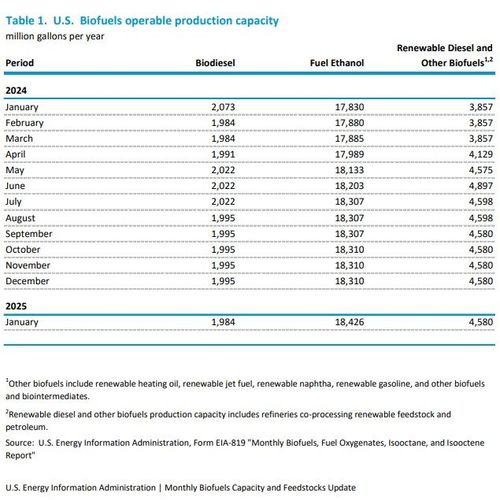EIA: US biofuel capacity increases in January, feedstock consumption falls

SOURCE: U.S. Energy Information Administration
April 2, 2025
BY Erin Voegele
U.S. operatable biofuels capacity increased slightly in January, with gains for ethanol, according to the U.S. Energy Information Administration’s latest Monthly Biofuels Capacity and Feedstock Update, released March 31. Feedstock consumption was down when compared to December.
Total biofuel capacity expanded to 24.99 billion gallons per year in January, up 105 MMgy when compared to the previous month, and up 1.23 billion gallons per year when compared to January 2024.
Ethanol capacity expanded to 18.426 billion gallons per year in January, up 116 MMgy when compared to December and up 596 MMgy when compared to January of the previous year.
Biodiesel capacity fell to 1.984 billion gallons per year in January, down 11 MMgy when compared to the previous month and down 89 MMgy when compared to January 2024.
Advertisement
Advertisement
Capacity for renewable diesel and associated biofuels, including renewable heating oil, renewable jet fuel, renewable naphtha, renewable gasoline and other biofuels and biointermediates, held steady at 4.58 billion gallons per year in January, unchanged since September 2024. When compared to January 2024, capacity for renewable diesel and associated biofuels was up 723 MMgy.
U.S. biofuel producers consumed approximately 28.903 billion pounds of feedstock in January, down 5.23% when compared to the previous month, but up 4.14% when compared to January of the previous year.
Biofuel producers consumed 26.204 billion pounds of corn in January, down from 26.861 billion pounds in December, but up when compared to the 24.7 billion pounds consumed in January of the previous year.
Grain sorghum consumption was at 353 million pounds in January, down from 372 million pounds the previous month, but up from 76 million pounds in January 2024.
Soybean oil consumption fell to 654 million pounds in January, with 384 million pounds of that volume going to biodiesel plants and 270 million pounds going to renewable diesel facilities. Soybean oil consumption was at 1.097 billion pounds in December, with 697 million pounds consumed for biodiesel and 400 million pounds consumed for renewable diesel, and at 960 million pounds in January 2024, with 545 million pounds going to biodiesel production and 416 million pounds going to renewable diesel production.
Advertisement
Advertisement
Corn oil consumption expanded to 358 million pounds in January, including 58 million pounds consumed for biodiesel and 299 million pounds consumed for renewable diesel. Corn oil consumption was at 320 million pounds in December, with 67 million pounds going to biodiesel produc9iton and 253 million pounds going to renewable diesel production, and at 335 million pounds in January 2024, with 71 million pounds consumed for biodiesel production and 364 million pounds consumed for renewable diesel.
Canola oil consumption fell to 193 million pounds in January, including 49 million pounds consumed by biodiesel facilities and 144 million pounds consumed for renewable diesel. Canola oil consumption was at 524 million pounds in December, including 132 million pounds consumed for biodiesel, and 392 million pounds consumed for renewable diesel, and at 376 million pounds in January of last year, with 153 million pounds going to biodiesel production and 224 million pounds going to renewable diesel production.
Biofuel producers also consumed 710 million pounds of tallow, 399 million pounds of yellow grease, and 32 million pounds of white grease in January. Consumption was at 707 million pounds, 540 million pounds, and 46 million pounds, respectively, in December and at 631 million pounds, 616 million pounds, and 45 million pounds, respectively, in January 2024.
The EIA withheld January data on the consumption of agriculture and forestry residues; other types of agriculture and forestry products; poultry fat; other types of waste oils, fats and grease; other vegetable oils; other recycled feeds and wastes; and other biofuel feedstocks not elsewhere specified or identified in order to avoid disclosure of individual company data.
Additional data is available on the EIA website.
Related Stories
Neste and DHL Express have strengthened their collaboration with the supply of 7,400 tons (9.5 million liters) of neat, i.e. unblended, Neste MY Sustainable Aviation Fuel to DHL Express at Singapore Changi Airport starting July 2025.
CoBank’s latest quarterly research report, released July 10, highlights current uncertainty around the implementation of three biofuel policies, RFS RVOs, small refinery exemptions (SREs) and the 45Z clean fuels production tax credit.
The USDA significantly increased its estimate for 2025-’26 soybean oil use in biofuel production in its latest World Agricultural Supply and Demand Estimates report, released July 11. The outlook for soybean production was revised down.
The U.S. Energy Information Administration maintained its forecast for 2025 and 2026 biodiesel, renewable diesel and sustainable aviation fuel (SAF) production in its latest Short-Term Energy Outlook, released July 8.
XCF Global Inc. on July 10 shared its strategic plan to invest close to $1 billion in developing a network of SAF production facilities, expanding its U.S. footprint, and advancing its international growth strategy.
Upcoming Events










